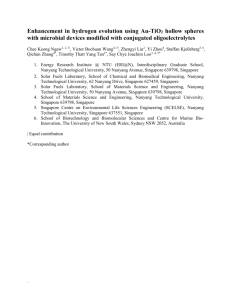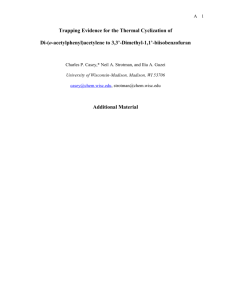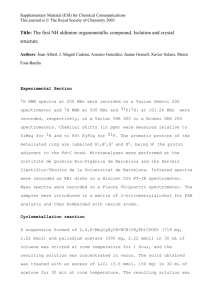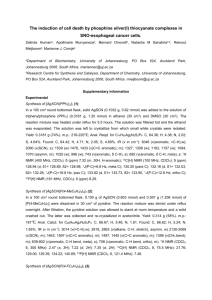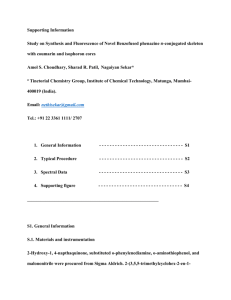POLA_24563_sm_suppinfo
advertisement
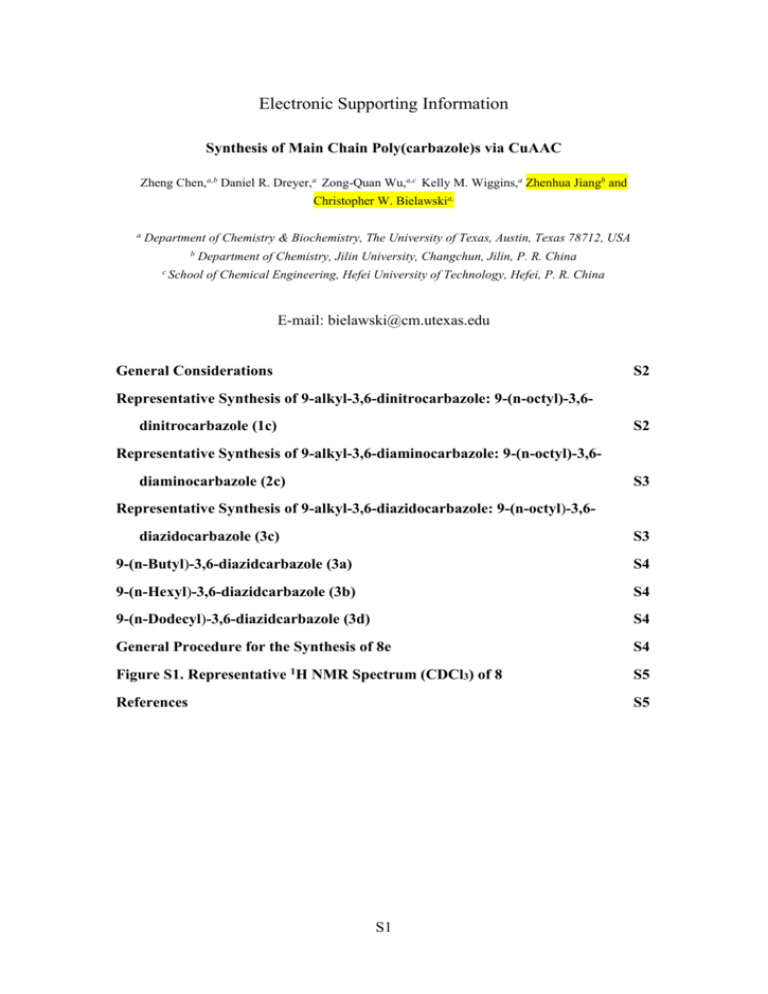
Electronic Supporting Information
Synthesis of Main Chain Poly(carbazole)s via CuAAC
Zheng Chen,a,b Daniel R. Dreyer,a Zong-Quan Wu,a,c Kelly M. Wiggins,a Zhenhua Jiangb and
Christopher W. Bielawskia,
a
Department of Chemistry & Biochemistry, The University of Texas, Austin, Texas 78712, USA
b
c
Department of Chemistry, Jilin University, Changchun, Jilin, P. R. China
School of Chemical Engineering, Hefei University of Technology, Hefei, P. R. China
E-mail: bielawski@cm.utexas.edu
General Considerations
S2
Representative Synthesis of 9-alkyl-3,6-dinitrocarbazole: 9-(n-octyl)-3,6dinitrocarbazole (1c)
S2
Representative Synthesis of 9-alkyl-3,6-diaminocarbazole: 9-(n-octyl)-3,6diaminocarbazole (2c)
S3
Representative Synthesis of 9-alkyl-3,6-diazidocarbazole: 9-(n-octyl)-3,6diazidocarbazole (3c)
S3
9-(n-Butyl)-3,6-diazidcarbazole (3a)
S4
9-(n-Hexyl)-3,6-diazidcarbazole (3b)
S4
9-(n-Dodecyl)-3,6-diazidcarbazole (3d)
S4
General Procedure for the Synthesis of 8e
S4
Figure S1. Representative 1H NMR Spectrum (CDCl3) of 8
S5
References
S5
S1
General Considerations. All solvents were purchased from Fisher Scientific and
used without additional further purification unless otherwise noted. The compounds
3,6-dinitrocarbazole,1–4
4,4′-diethynylbiphenyl
(5),5
4-diethynyl-2,56
bis(octyloxy)benzene (6)
and 1,4-diethynyl-2,5-didodecyloxybenzene (7)7 were
prepared according literature procedures. All other chemicals were purchased from
Aldrich, Alfa Aesar, or Acros Organics, and were used as received. 1H and 13C{1H}
NMR spectra were recorded using a Varian 300, 400, or 500 MHz spectrometer.
Chemical shifts are reported in delta (δ) units and expressed in parts per million (ppm)
downfield from tetramethylsilane using the residual solvent as an internal standard
(CDCl3, 7.26 ppm for 1H and 77.0 ppm for 13C; DMSO-d6, 2.49 ppm for 1H and 39.5
ppm for 13C). Coupling constants (J) are expressed in hertz (Hz). Gel permeation
chromatography (GPC) was performed at ambient temperature on a system equipped
with a Waters Model 510 HPLC pump, two fluorinated polystyrene columns
(IMBHW-3078 and I-MBLMW-3078) arranged in series, and a Waters 486 Tunable
Absorbance Detector (λ = 450 nm). Molecular weight and polydispersity data are
reported relative to polystyrene standards in tetrahydrofuran (THF). IR spectra were
recorded on a Perkin-Elmer BX FT-IR spectrometer using KBr pellets. UV-vis
spectra were recorded using a Perkin Elmer Lambda 35 spectrometer. Emission
spectra were recorded using a QuantaMaster Photon Technology International
fluorometer. Melting points were obtained with a Mel-Temp apparatus and are
uncorrected. High resolution mass spectra (HRMS) were obtained with a VG
analytical ZAB2-E instrument (ESI or CI). Differential scanning calorimetry (DSC)
was performed using a Mettler-Toledo DSC823e under an atmosphere of nitrogen at a
heating/cooling rate of 10 °C·min−1. Thermogravimetric analysis (TGA) was
performed using a Mettler-Toledo TGA/SDTA 851 under an atmosphere of nitrogen
at a heating rate of 10 °C·min−1. Elemental analyses were performed at Midwest
Microlab, LLC (Indianapolis, IN).
Representative Synthesis of 9-alkyl-3,6-dinitrocarbazole: 9-(n-octyl)-3,6dinitrocarbazole (1c). A 500 mL flask was charged with 3,6-dinitrocabazole (2.57 g,
10 mmol) and THF (320 mL). The resulting solution was heated to reflux, and NaOH
(0.8 g, 20 mmol) was added. After 1 h, l-bromooctane (3.86 g, 20 mmol) was added to
the refluxing solution dropwise over 0.5 h. After refluxing for 8 h, the solvents were
removed under reduced pressure, and 200 mL water was added to the flask. A yellow
solid was collected by filtration and washed with 500 mL of hot water. The crude
mixture of yellow solid was recrystallized from THF and isolated by vacuum
filtration. Subsequent drying under reduced pressure afforded the desired product as
yellow needles (3.04 g, 82% yield). m.p. 121–122 °C. FT-IR (cm−1): (C–H, Ar) 3086–
3065; (C-H, -CH3) 2963; (C–H, -CH2-) 2925, 2853; (–NO2), 1515, 1313; (C=C, Ar)
1600, 1475. 1H NMR (300 MHz, DMSO-d6): δ 9.48 (s, 2H, Ar); 8.38 (d, J = 8.1 Hz,
2H, Ar); 7.38 (d, J = 9.0 Hz, 2H, Ar); 4.56 (t, J = 8.4 Hz, 2H, –N–CH2–); 1.79 (m,
2H, -CH2-); 1.16-1.25 (m, 10H, -CH2-); 0.79 (t, J = 6.6 Hz, 3H, R-CH3). 13C NMR
(100 MHz, CDCl3): δ 146.3 (Ar); 143.6 (Ar); 125.7 (Ar); 125.3 (Ar); 114.5 (Ar);
110.2 (Ar); 43.8 (N-CH2-); 34.9 (-CH2-); 31.8(-CH2-); 29.4 (-CH2-); 29.7 (-CH2-);
S2
30.0 (-CH2-); 22.7 (-CH2-); 21.9 (-CH2-); 14.2 (R–CH3). HRMS calcd for C20H23N3O4
[M]+: 369.1734; found: 369.1733. Anal. Calcd for C20H23N3O4: C, 65.03; H, 6.28; N,
11.37; found: C, 64.93; H, 6.22; N, 11.54. Spectroscopic data for 1a, 1b, and 1d were
in accord with literature values.3
Representative Synthesis of 9-alkyl-3,6-diaminocarbazole: 9-(n-octyl)-3,6diaminocarbazole (2c). A 100 mL flask was charged with 1c (1.85 g, 5 mmol), Pd/C
(0.1 g), and EtOH (40 mL). The resulting slurry was mechanically stirred at reflux for
1 h under N2. The flask was then charged with NH2NH2·H2O (2 mL; 71% aqueous
solution) dropwise. After 4 h, the reaction mixture was vacuum filtered and the
solvent was removed under reduced pressure. The resulting residue was then
recrystallized from ethanol (10 mL), which afforded light yellow needle crystals that
were isolated by vacuum filtration. Subsequent drying under reduced pressure
afforded the desired product as light yellow needles crystals (2.20 g, 71% yield). m.p.
131–132 °C. FT-IR (cm-1): 3385, 3293 (-NH2); 3048, 3019 (C-H, Ar); 2965 (C-H,
-CH3); 2917, 2848 (C-H, -CH2-); 1580, 1495, 1475 (C=C, Ar). 1H NMR (300 MHz,
DMSO-d6): 7.13 (d, J = 8.4 Hz, 2H, Ar-H); 7.07 (s, 2H, Ar-H); 6.71 (d, J = 8.4 Hz,
2H, Ar-H); 4.58 (s, 2H, -NH2); 4.11 (t, J = 6.6 Hz, 2H, -N-CH2-); 1.64–1.68 (m, 2H, CH2-); 1.21–1.24 (m, 10H, -(CH2)5-), 0.81 (t, J = 6.2 Hz, 3H, -CH3). 13C NMR (100
MHz, CDCl3): 147.0 (Ar); 109.1 (Ar); 127.2 (Ar); 144.0 (Ar); 116.1 (Ar); 124.1
(Ar); 43.2 (N-CH2); 34.2 (-CH2-); 31.8 (-CH2-); 30.0 (-CH2-); 29.6 (-CH2-); 29.3(CH2-); 22.7 (-CH2-); 21.9 (-CH2-); 14.2 (-CH3). HRMS calcd for C20H27N3 [M]+:
309.2208; found: 309.2207. Anal. Calcd for C20H27N3: C, 77.63; H, 8.79; N, 13.58;
found: C, 77.35; H, 8.71; N, 13.82. Spectroscopic data for 2a, 2b, and 2d were in
accord with literature values.3
Representative Synthesis of 9-alkyl-3,6-diazidocarbazole: 9-(n-octyl)-3,6diazidocarbazole (3c). A 250 mL flask was charged with 2c (1.55 g, 5 mmol),
aqueous HCl (14.4 mL, 12.1 M) and water (72 mL), which formed a slurry that was
then cooled to 10 °C. To the cooled slurry was added sodium nitrite (1.5 g, 22 mmol)
dissolved in water (7.2 mL). The resulting mixture was stirred for 25 min at 10 °C and
then vacuum filtered. The filtrate was then warmed to 25 °C, and charged with
sodium azide (1.73 g, 26 mmol) dissolved in water (14.4 mL). The solution was
stirred 2 h at 25 °C after which time a precipitate was collected by vacuum filtration,
washed with water and dried over calcium chloride under reduced pressure.
Subsequent drying under reduced pressure afforded the desired product as a yellow
powder (1.36 g, 75% yield). m.p. 102–104 °C. FT-IR (cm-1): 2949 (C-H), 2924 (C-H),
2855 (C-H), 2113 (N3), 1484 (Ar). 1H NMR (300 MHz, CDCl3): 7.68 (d, J = 2.4 Hz,
2H, Ar-H); 7.35 (d, 2H, J = 8.8 Hz, Ar-H); 7.14 (dd, J1 = 2.4 Hz, J2 = 2.0 Hz, 2H, ArH); 4.25 (t, 2H, J = 3.2 Hz, -N-CH2-); 1.76–1.90 (m, 2H, -CH2-); 1.20–1.42 (m, 10H,
-(CH2)5-), 0.86 (t, 3H, J = 6.8 Hz, -CH3). 13C NMR (100 MHz, CDCl3): 138.5 (Ar),
131.3 (Ar), 122.9 (Ar), 117.9 (Ar), 110.4 (Ar), 110.0 (Ar), 43.4 (N-CH2), 31.5 (-CH2), 28.9 (-CH2-), 26.9 (-CH2-), 22.5 (-CH2-), 14.0 (-CH3). HRMS calcd for C20H24N7
S3
[M + H]+: 362.2095; found: 362.2093. Anal. Calcd for C20H23N7: C, 66.46; H, 6.41;
N, 27.13; found: C, 66.18; H, 6.50; N, 27.42.
9-(n-butyl)-3,6-diazidcarbazole (3a). Yield: 0.96 g (72%). m.p. 95–96 °C. FT-IR
(cm-1): 2956 (C-H, -CH3), 2932 (C-H), 2869 (C-H), 2110 (N3), 1577 (Ar), 1484 (Ar).
1
H NMR (300 MHz, CDCl3): 7.67 (d, J = 2.0 Hz, 2H, Ar-H); 7.35 (d, 2H, J = 8.4
Hz, Ar-H); 7.14 (dd, J1 = 2.4 Hz, J2 = 2.4 Hz, 2H, Ar-H); 4.25 (t, 2H, J = 3.2 Hz, -NCH2-); 1.77–1.88 (m, 2H, -CH2-); 1.31–1.43 (m, 2H, -CH2-), 0.95 (t, 3H, J = 7.4 Hz,
-CH3). 13C NMR (100 MHz, CDCl3): 138.5 (Ar), 131.2 (Ar), 122.8 (Ar), 117.9 (Ar),
110.4 (Ar), 110.0 (Ar), 43.2 (N-CH2), 31.0 (-CH2-), 20.4 (-CH2-), 13.9 (-CH2-).
HRMS calcd for C16H15N7 [M]+: 305.3522; found: 305.3523. Anal. Calcd for
C16H15N7: C, 62.94; H, 4.95; N, 32.11; found: C, 63.22; H, 5.25; N, 31.82.
9-(n-hexyl)-3,6-diazidcarbazole (3b). Yield: 1.21 g (70%). m.p. 97–98 °C. FT-IR
(cm-1): 2956 (C-H, -CH3), 2932 (C-H), 2869 (C-H), 2105 (N3), 1587 (Ar), 1483 (Ar).
1
H NMR (300 MHz, DMSO-d6): δ 8.11 (s, 2H, Ar-H); 7.64 (d, J = 9.0 Hz, 2H, Ar-H);
7.18 (d, J = 11.1 Hz, 2H, Ar-H); 4.37 (t, J = 6.6 Hz, 2H, -N-CH2-); 1.71–1.72 (m, 2H,
-CH2-); 1.22–1.23 (m, 10H, -(CH2)5-), 0.79 (t, J = 5.1 Hz, 3H, -CH3). 13C NMR (100
MHz, CDCl3): δ 138.5 (Ar), 131.2 (Ar), 122.8 (Ar), 117.8 (Ar), 110.4 (Ar), 110.0
(Ar), 43.1 (N-CH2), 31.1(-CH2-), 30.1 (-CH2-), 29.7 (-CH2-), 20.5 (-CH2-), 13.9
(-CH3). HRMS calcd for C18H20N7 [M + H]+: 334.1780; found: 334.1780. Anal. Calcd
for C18H19N7: C, 64.85; H, 5.74; N, 29.41; found: C, 64.57; H, 5.61; N, 29.61.
9-(n-dodecyl)-3,6-diazidcarbazole (3d). Yield: 1.07 g (78%). m.p. 96–97 °C. FTIR
(cm-1): 2952 (C-H,-CH3), 2920 (C-H), 2848 (C-H), 2111 (N3), 1579 (Ar), 1486 (Ar),
1462 (Ar). 1H NMR (300 MHz, CDCl3): 7.69 (d, J = 2.8 Hz, 2H, Ar-H); 7.35 (d, 2H,
J = 8.8 Hz, Ar-H); 7.14 (dd, J1 = 2.4 Hz, J2 = 2.4 Hz, 2H, Ar-H); 4.25 (t, 2H, J = 3.2
Hz, -N-CH2-); 1.77–1.89 (m, 2H, -CH2-); 1.16–1.40 (m, 18H, -(CH2)9-), 0.88 (t, 3H, J
= 6.8 Hz, -CH3). 13C NMR (100 MHz, CDCl3): 138.5 (Ar), 131.3 (Ar), 122.8 (Ar),
117.9 (Ar), 110.4 (Ar), 110.0 (Ar), 43.4 (N-CH2), 31.9 (-CH2-), 29.5 (-CH2-), 28.9
(-CH2-), 27.3 (-CH2-), 22.7 (-CH2-), 14.1 (-CH3). HRMS calcd for C24H31N7 [M]+:
417.2642; found: 417.2641. Anal. Calcd for C24H31N7: C, 69.04; H, 7.48; N, 23.48;
found: C, 69.23; H, 7.58; N, 23.27.
General Procedure for the Synthesis of 8e. A 10 mL flask was charged with THF (8
mL), CH3CN (2 mL), 3d (0.418 g, 1 mmol) and 7 (0.495 g, 1 mmol). The resulting
solution was degassed with argon for 10 min and then charged with a piece of
copper(0) wire (5 mg), a catalytic amount of CuI (4 mg, 0.02 mmol) and N,Ndiisopropylethlamine (DIPEA; 16 mg, 0.12 mmol). The reaction vessel was then
wrapped in aluminum foil and the reaction mixture was stirred for one week at 80 °C
under a static argon atmosphere. Upon removal of the foil, it was observed that the
initial orange solution turned to dark brown. A large excess of methanol (100 mL)
was added to the resulting solution and the crude polymer which precipitated was
collected by vacuum filtration. To separate the residual copper and other impurities,
S4
the polymer was dissolved in THF and the resulting solution poured into excess
methanol. The precipitated solids were collected by vacuum filtration and washed
with water (3 50 mL). The polymer was then re-dissolved in THF (5 mL) and the
resulting solution was poured into methanol (50 mL). After standing for ten minutes,
the precipitate that formed was vacuum filtered and washed with ethyl acetate.
Subsequent drying under vacuum afforded the desired material as a solid. Yield: 0.72
g (79%). 1H NMR (300 MHz, CDCl3): 8.41 (s), 7.88–7.79 (br), 7.44–7.32 (br), 7.26
(s), 4.59–4.41 (br), 4.35–4.27 (br), 2.01–1.85 (br), 1.70–1.61 (br), 1.59–1.42 (br),
1.41–1.25 (br), 1.13–0.82 (br).
Figure S1. Representative 1H NMR Spectrum (CDCl3) of 8.
References
1. M. S. Mudadu, A. N. Singh and R. P. Thummel, J. Org. Chem., 2008, 73, 6513–
6520.
2. S. Koyuncu, I. Kaya, F. B. Koyuncu and E. Ozdemir, Synth. Met., 2009, 159,
1034–1042.
3. I. Kaya and S. Koyuncu, J. Appl. Polym. Sci., 2009, 113, 1975–1985.
4. S. C. Maity, D. Mal and M. M. Maiti, Thermochim. Acta, 2005, 435, 135–141.
5. J. S. Park, J. N. Wilson, K. I. Hardcastle, U. H. F. Bunz and M. Srinivasarao, J.
Am. Chem. Soc., 2006, 128, 7714–7715.
6. X. F. Liu, M. Zhu, S. H. Chen, M. J. Yuan, Y.B. Guo, Y. L. Song, H. B. Liu and
Y. Y. Li, Langmuir, 2008, 24, 11967–11974.
7. C. S. Andersen and K. V. Gothelf, Org. Biomol. Chem., 2009, 7, 58–60.
S5

